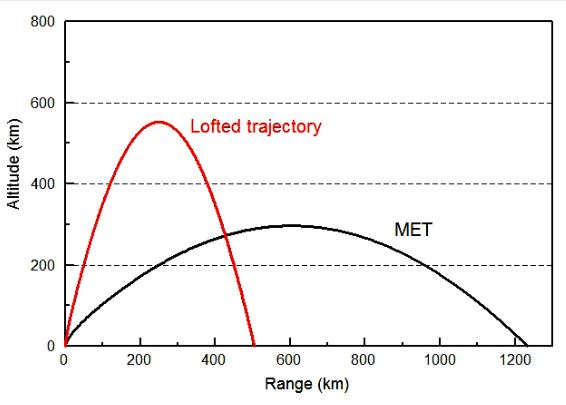A week after the test launch of an intermediate-range Hwasong-12 missile, North Korea today tested a medium-range missile. Based on press reports, this appears to be a Pukguksong-2 missile, which is the land-based version of the submarine-launched missile it is developing. This appears to be the second successful test of this version of the missile.
South Korean sources reported this test had a range of 500 kilometers (km) (300 miles) and reached an altitude of 560 km (350 miles). If accurate, this trajectory is essentially the same as the previous test of the Pukguksong-2 in February (Fig. 1). Flown on a standard trajectory, this missile carrying the same payload would have a range of about 1,250 km (780 miles). If this test were conducted with a very light payload, as North Korea is believed to have done in past tests, the actual range with a warhead could be significantly shorter.

Fig. 1: The red curveis reportedly the trajectory followed on this test. The black curve (MET=minimum-energy trajectory) is the same missile on a maximum range trajectory.
The Pukgukgsong-2 uses solid fuel rather than liquid fuel like most of North Korea’s missiles. For military purposes, solid-fueled missiles have the advantage that they have the fuel loaded in them and can be launched quickly after they are moved to a launch site. By contrast, large liquid-fuel missiles must be without fuel and then fueled after they are in place at the launch site. This process can take an hour or so, and the truck carrying the missile must be accompanied by a number of trucks containing fuel. So it is easier to detect a liquid missile before launch and there is more time to attack it.
However, it is easier to build liquid missiles, so that is typically where countries begin. North Korea obtained liquid fuel technology from the Soviet Union in the 1980s and built its program from there. North Korea is still in early stages of developing solid missiles.
Building large solid missiles is difficult. If you look at examples of other countries building long-range solid missiles, such as France and China, it took them several decades to get from the point of building a medium-range solid missile, which North Korea has done, to building a solid ICBM. So this is not something that will happen soon, but with time North Korea will be able to do it.
